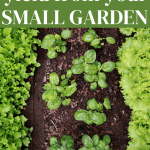Make The Most Of Your Small Garden Space
With a short growing season and limited garden space, you can get the most out of your small garden by implementing some simple gardening tactics. Increase harvest yield in your small garden space with these four planting strategies.

With limited garden space and a short growing season in Colorado, we have to get creative when it comes to growing all the crops we want. We have a few workarounds and tricks up our sleeve to increase harvest yield without having acres of land to garden with.
Our strategies involve season extending, succession planting and interplanting among other tactics. Read on to discover how we get the most out of our small garden space.
Season Extending
- Start Early
While snow lingers on the ground outside, we’re already starting seeds inside and calculating when to plant. - Raised Beds
Since the soil level in a raised bed is above the ground, it warms up quicker than the ground soil in the spring. That means we’re able to plant earlier in the season using raised garden beds. It’s a great way to extend the gardening season. - Hoop Tunnels
We use hoop tunnels constructed with plastic greenhouse film to create a warm environment for early season crops. By using hoop tunnels, we get our first crop several weeks earlier than would be possible without protection. With our strategy for succession planting described below, the early start means we can squeeze in an extra crop harvest. We use a series of PVC pipes fastened with conduit straps to the outside of our raised beds to construct the hoop tunnels. This PVC frame is covered with greenhouse film and attached with snap clamps.
Maximize Yield Using These Strategies For Plant Spacing
We use a strategic spacing strategy for our plants to maximize yield in our small garden. The backs of seed packets have information on the recommended spacing between plants and row spacing. We ignore the row spacing recommendations since we’re planting in raised beds and don’t walk between rows.
- Maximize space by staggering your plants so that mature plants are spaced on a diagonal from neighboring plants. We plant using the closest recommended spacing. To grow two different crops next to each other, you take the recommended spacing for each crop, add them together and divide by two. That gives you a measurement for how far apart to plant the two crops.
See our intensive plant spacing guide at the end of this post for specific measurements.
- Remember that the spacing recommendations are based on plant size maturity. This is where we get creative and squeeze lots of additional yield out of our plantings. The seedlings of many crops can be eaten—think of those expensive bags of baby greens at the grocery store. We sow our leafy green seeds closer together than the recommended final spacing on the seed packet. In a few weeks, we have lots of baby greens.
- We start the process of thinning by harvesting some of the baby greens and using them in salads. We continue to thin over the next few weeks. We’re left with plants that reach maturity at the final recommended spacing.
Succession Planting
As our first crops are planted outside under hoop tunnels in the early spring, we’re already thinking ahead to harvesting and planting a new mid-summer crop in that space. This gardening strategy is called succession planting.
We’re able to maximize our harvest by planting two or more crops in the same garden space at different times during the growing season.
The key is to follow a rapidly growing early season crop with another crop that can grow through the summer. The second crop reaches maturity before the ground freezes in the fall.
We plant spinach and lettuce in early spring, harvest it, then plant beets and kohlrabi in the same spot. That way we have a consistent supply of vegetables all season long. If possible, a cold weather crop is planted after the summer crop is harvested. Using this method can DOUBLE or TRIPLE your garden space.
First: peas, lettuce, spinach, bok choy, mustard greens, radish
Second: beets, kohlrabi, chard, carrots, broccoli (for fall harvest), kale, onions
The Little Green Yard has an in-depth explanation of the carrot seed production process and following best practices for seed germination will greatly increase your chances of growing healthy, delicious carrots in your garden.
Interplanting Crops
Interplanting involves growing two crops in the same garden space. We plant fast-growing crops among slow growers. By the time the slow growers need more room, we’ve already harvested the fast growers. Crops like lettuce also benefit from the shade provided by slow growing companions as they reach larger size during the hot summer months.
Fast growers: radish, lettuce, mustards, bok choy, spinach, kale (baby greens), swiss chard (baby greens)
Slow growers: broccoli, cabbage, cauliflower, tomato, carrots
Grow Vertically
If you have limited garden space, get creative by planting vegetables that climb or vine, like pole beans. They take up less ground space than bush beans. We plant cucumbers at the base of a trellis and they climb up instead of hogging space in our garden bed. Peas, cucumbers, melons, and squash can also grow up a trellis.


More Gardening Inspiration
Photo images via Adobe Stock. All infographic images created by Umbel Organics.




